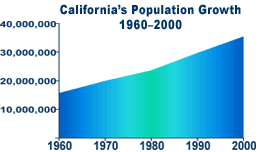In California, this has been a very dry winter after several years of above-average rainful, at least in the north. It has been a while since the state has had a drought, and population growth has been explosive in the last few decades because of legal and illegal immigration [
Rainy season falls short so far, San Francisco Chronicle 1/30/07].
![California population growth]()
But the lack of rainfall nevertheless evokes memories of relatively recent droughts, including a six-year one in the late 1980s and early 1990s and a two-year episode in the late 1970s that threatened to dry up state reservoirs before conditions improved with a "March Miracle" of heavy rain. The state's population is much larger now and would be harder-hit by a severe drought, experts said.
"We have far greater water demands than we did 30 years ago," Gudgel said. "We don't have the leeway we had in 1977."
In 1977, California's population was fewer than 23 million. Today, the state is home to over 36.5 million residents.
During the 70s drought, residents of northern California had to live with severe water restrictions. People put bricks in their toilet tanks (this was before conservationist units) and used recycled water to keep their gardens alive.
If the rains don't come, Californians will have to ration water far earlier than would have been necessary before immigration became a tsunami. If residents of the Golden State have to endure Navy showers, they can thank an "immigrant." Natural resources are finite, and there's only so much that technology can do to shield us from that basic fact.













